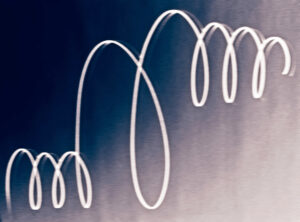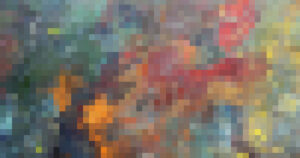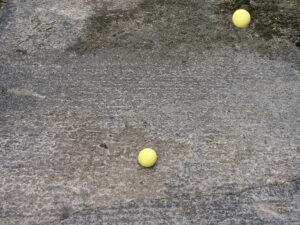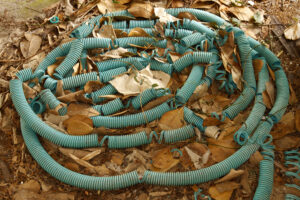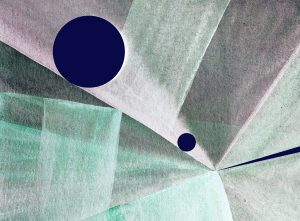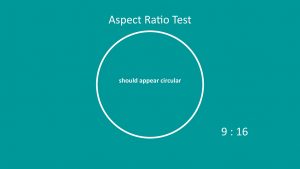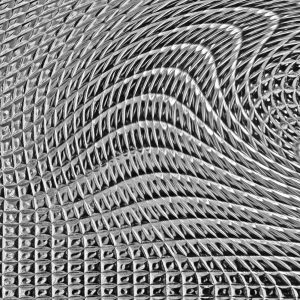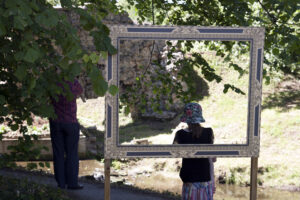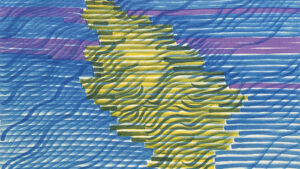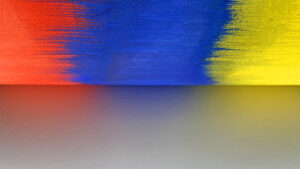
Paint on carpet, 4 x 8 m
Installation view
Latvian National Museum of Art
It took me nearly a decade of regular trips to Paris before I finally decided to visit The Louvre. My interest in art is considerable, and it is not that I resent traditional ways of displaying it. It was rather my inability to connect such an enormous historical collection with contemporary ways of thinking and experiencing art. There is no doubt that current social interactions, aspirations and material representations of today’s values differ from those of two hundred years ago, when this particular museum was established. It seems I was more inclined to explore contemporary art rather than artefacts from the distant past. With great respect to The Louvre, I chose instead to visit The Centre Pompidou.
What exactly are the specifics of experiences while visiting any national art gallery or state museums of art? What do they represent and how to reflect on the vast number of exhibits which are out of their historical context and almost always represent only a fragment of the unknown whole? Many ‘national’ galleries have vast international representation, which can be confusing. The situation is further confused by the large private collections that have been opened to the general public. The selection of artefacts here is often very eclectic, with feelings of randomness and a lack of methodology in the process of collecting. Who really knows what was in the mind of the original collector; Patronage, personal taste or profit? The private collections and museums which are built to display the exhibits are more often evidence of the brilliance and commercial skills of the creator – collector rather than an exploration of the phenomenon of art.
We go to a museum for an experience, or do we? Each of us has got different background interests and expectations of an encounter with artworks. Nevertheless, a museum visit requires the acceptance of specific behavioural patterns and only after following these unwritten (and sometimes written rules) can we establish a relationship between the displayed artefacts and ourselves. A museum becomes ‘alive’ only when there is the presence of these relationships, otherwise it would remain merely a storage space for the pieces in the collection. There will be a big difference in the experience depending on whether or not we have any background knowledge and understanding about what we are encountering. The purpose of the visit is intrinsic to the experience. Do we come to museums to take our ‘selfie’ next to the popular painting or maybe we are just here to meet friends or escape an unpleasant ‘outside’ environment? We all have different motivations and reasons to be in a museum.



The Louvre
The traditional function of the museum – to collect, preserve, display and provide the interpretation is accepted and even taken for granted. We do take, as viewers, what we are given or we ignore what ‘is not for us’. The themes and arrangements are in front of us and we encounter them. This is the moment where the educational role of the museum can become apparent. It reveals the role of the museum as an important institution in a wider cultural context.
It also presents a moment of danger. Is the cultural context being presented or promoted? It is all too easy for the line between information and propaganda to be crossed.
What museums tend to do is add interpretation of the works. However, this inevitably means the distance between the creator – artist and the viewer – perceiver of the artwork is extended and modified by the existence of the museum. Where is the creator in the interpretation? Who is in charge of the choices of curatorial and display methods? Who are the possible viewers and who determines what is expected from them in a museum space? It is obvious that, through its interpretation, a museum is an institution which has got enormous power.
So how does the power manifest itself and how can it be controlled? The most obvious manifestation is in the “Treachery of the text”. For someone approaching an exhibition with a deal of background knowledge of the subject matter the annotations and explanatory notes provided can be seen as an irritation or an irrelevance. However, for the less informed they can be an invaluable insight and foundation for further exploration and understanding.
Whether the reader is being guided or misguided remains a question open to debate by those with views in line with the text or opposing the interpretation. Which brings us to the matter of controls. There are two possibilities, in the first instance there is peer review, those with knowledge of the subject can enter into academic discourse and highlight the degree to which the interpretation stands up to scrutiny.
The second control lies with the viewer themselves. Just because the vast majority of those in the know agree with the interpretation, it doesn’t mean that an individual, whatever their background, can’t find something additional for themselves, based on their own experiences, in the space created by the original artist. It is often the case that one work inspires the creation of a new thought or interpretation, which can result in a new work. “Ceci n’est pas une verité”[1] should be the caption to every annotation.

Until recently, in spite of different innovative architectural solutions, the Museum in large remains as it was a hundred or two hundred years ago – a place where things are collected, preserved and displayed. So, what is a future Museum? To what extent will it persist as a continuum of the 19th century model? How much will some newer forms of interaction with the visual arts, such as virtual tours, use of virtual reality and exhibit interactions take over? Will it rise or fall in importance as a place for education and creativity?
Necessity, created by the restrictions on movement and physical visits imposed over the last year or so, has accelerated the proliferation of online and virtual collections and experiences. When restrictions are relaxed it will be interesting to see how much the balance returns to traditional operations and to what extent online collections are seen as an alternative or an extension to museum practice. Maybe the expansion of the newer dimension will also increase the possibility of a third control. With the extended reach of the virtual world there is the possibility to offer multiple interpretations and wider debate. Or does that just introduce more confusion?
[1] “This is not a truth” with reference to René Magritte, The treachery of images: “This is not a pipe”.

Tate Modern, London 
Tate Modern, London 
Louis Vuitton Foundation, Paris 
The art museum opened in October 2014 
MUDAM, The Contemporary Art Museum of Luxembourg
